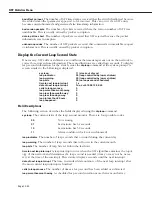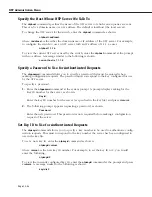
NTP Access Control Menu
Page 12-36
NTP Access Control Menu
To view the
NTP
Access Control Menu, enter the
ntaccess
command at the system prompt. If
you are using verbose mode the
NTP
configuration menu is displayed. Otherwise, enter a
question mark (
?
) at the prompt to display this menu:
Command
NTP Access Control Menu
---------------
--------------------------------------------------------
ntpreqk
change the request message authentication keyid
ntpctlk
change the control message authentication keyid
ntpckey
add one or more key ID's to the trusted list
ntpvkey
display the trusted key ID list
ntpdkey
remove one or more key ID's from the trusted list
ntpauth
display the state of the authentication code
ntpcres
create restrict entry/add flags to entry
ntpvres
view the server's restrict list
ntpmres
remove flags from a restrict entry
ntpdres
delete a restrict entry
ntpctrap
configure a trap in the server
ntpvtrap
display the traps set in the server
ntpdtrap
remove a trap (configured or otherwise) from the server
Related Menus:
Ntconfig Ntinfo Ntstats Ntadmin Ntaccess
The main menu options are shown in the
Related Menus
list for quick access if you need to
change menus.
Change the Request Message Authentication Key ID
There are two types of messages an
NTP
entity can send to another
NTP
entity: request and
control. Request messages ask for information from the
NTP
entity such as timestamp informa-
tion, statistics, etc. It is possible to change the authentication key identifier for request
messages sent from the switch to another
NTP
entity.
To change the authentication key
ID
, enter the
ntpreqk
command as shown:
ntpreqk <value>
where
<value>
is the new key
ID
. Press
<return>
, and a brief message is displayed confirming
the operation.
♦
Note
♦
The authentication key
ID
must match in both the
switch sending the message and the switch receiving
the message.
Summary of Contents for Omni Switch/Router
Page 1: ...Part No 060166 10 Rev C March 2005 Omni Switch Router User Manual Release 4 5 www alcatel com ...
Page 4: ...page iv ...
Page 110: ...WAN Modules Page 3 40 ...
Page 156: ...UI Table Filtering Using Search and Filter Commands Page 4 46 ...
Page 164: ...Using ZMODEM Page 5 8 ...
Page 186: ...Displaying and Setting the Swap State Page 6 22 ...
Page 202: ...Creating a New File System Page 7 16 ...
Page 270: ...Displaying Secure Access Entries in the MPM Log Page 10 14 ...
Page 430: ...OmniChannel Page 15 16 ...
Page 496: ...Configuring Source Route to Transparent Bridging Page 17 48 ...
Page 542: ...Dissimilar LAN Switching Capabilities Page 18 46 ...
Page 646: ...Application Example DHCP Policies Page 20 30 ...
Page 660: ...GMAP Page 21 14 ...
Page 710: ...Viewing the Virtual Interface of Multicast VLANs Page 23 16 ...
Page 722: ...Application Example 5 Page 24 12 ...
Page 788: ...Viewing UDP Relay Statistics Page 26 24 ...
Page 872: ...The WAN Port Software Menu Page 28 46 ...
Page 960: ...Deleting a PPP Entity Page 30 22 ...
Page 978: ...Displaying Link Status Page 31 18 ...
Page 988: ...Displaying ISDN Configuration Entry Status Page 32 10 ...
Page 1024: ...Backup Services Commands Page 34 14 ...
Page 1062: ...Diagnostic Test Cable Schematics Page 36 24 ...
Page 1072: ...Configuring a Switch with an MPX Page A 10 ...
Page 1086: ...Page B 14 ...
Page 1100: ...Page I 14 Index ...






























